Last Updated December 10, 1998 by Robin Harris
First published in the February 1996 Buffalo, the monthly publication of The Winnipeg Philatelic Society.
The stamp was first released on July 6, 1978, printed by the British American Bank Note (BABN) with a plate 1 inscription (pictured to right) (panes of 50 - 5 columns by 10 rows). The BABN uses photogravure printing. This method of printing typically results in a mottle (fuzzy) appearance. They printed a total of 8,650,000 stamps - this is scott#723.
As you study these stamps, you will learn to sort the stamps by their appearance (the grain elevator on the BABN printing appears "orangy" while on the CBN printings it appears "browner"). It does take a bit of practising but once spotted, is very noticeable. Another method of determining whom the printer is can be found in the location of the "hidden date". On the BABN printing, the date is found on the door of the grain elevator, reading up; on the CBN printings, the date is found on the license plate of the car in the foreground. [One prominent Canadian catalogue suggests that this is a constant plate variety when in fact it is a normal design element!].
Study Tip #7: The thrill of a new find is overwhelming and well worth the hunt.
I purchased mint blocks of 15 (5x3) from the top of both plates while these stamps were current to confirm the varieties' position (the occurrence of this plate variety is similar to the famous Kreighoff flaw in 1972). Spotting a constant variety before anyone else has found it is quite a thrill! This variety occurs with a 1 in 10 ratio and with many stamps printed, it is quite common (there should be 8.525 million, nearly as many as the entire BABN printing). Due to its position, the two upper plate blocks will contain this variety (twice in four stamps).
Based upon the total number of stamps printed and the relative nature of the varieties, one can make projections on what the value of each stamp should be - what the catalogue lists is another matter!
We will make the assumption that the CBN printing (having the largest quantity printed) is valued at 10c for a used copy. The table below shows the resulting calculations and a count of my inventory of 734 used specimens from all plates.
The BABN printing is also known untagged ($40 used); the CBN printing can be found with 1-bar tagging ($60-100 used). Perfins from the CN railroad are known on both the BABN and CBN printings.
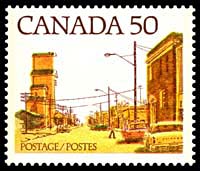 The 50c Prairie Town street scene stamp first issued in 1978 is a great stamp to study. Two different printers printed it (each having very distinctive printing methods resulting in two major Scott catalogue number) and there are three very noticeable constant plate varieties - all of which should be listed in a catalogue but are not.
The 50c Prairie Town street scene stamp first issued in 1978 is a great stamp to study. Two different printers printed it (each having very distinctive printing methods resulting in two major Scott catalogue number) and there are three very noticeable constant plate varieties - all of which should be listed in a catalogue but are not.
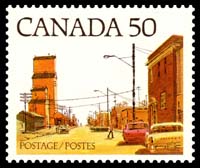 On December 13, 1978 the stamp was released a second time. However, the Canadian Bank Note (CBN) did this printing with a plate 2 inscription (pictured to left). The CBN uses lithography printing. This method of printing typically results in a solid appearance of the colours. On April 6, 1981 a third printing was released, also printed by CBN, with a plate 3 inscription. A total of 85,250,000 stamps were printed by the CBN - this is scott#723A. Notice that there were approximately ten times as many CBN stamps printed.
On December 13, 1978 the stamp was released a second time. However, the Canadian Bank Note (CBN) did this printing with a plate 2 inscription (pictured to left). The CBN uses lithography printing. This method of printing typically results in a solid appearance of the colours. On April 6, 1981 a third printing was released, also printed by CBN, with a plate 3 inscription. A total of 85,250,000 stamps were printed by the CBN - this is scott#723A. Notice that there were approximately ten times as many CBN stamps printed.
Plate Varieties
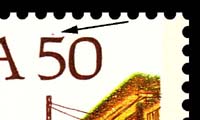 What about the constant plate varieties? This is what the used accumulator loves to search for! The BABN printing (sc 723) has one: a red dot appears above the '5' in '50' on stamp 5 (row 1/column 5) of the pane. It occurs on about half of the panes and happens to fall in the upper right plate block. Since there are 50 stamps per pane and this variety occurs on about every other pane, that is a 1 in 100 ratio for this variety - with a total printing of 8.65 million stamps, that would result in about 86,500 stamps with the variety (not a very large number).
What about the constant plate varieties? This is what the used accumulator loves to search for! The BABN printing (sc 723) has one: a red dot appears above the '5' in '50' on stamp 5 (row 1/column 5) of the pane. It occurs on about half of the panes and happens to fall in the upper right plate block. Since there are 50 stamps per pane and this variety occurs on about every other pane, that is a 1 in 100 ratio for this variety - with a total printing of 8.65 million stamps, that would result in about 86,500 stamps with the variety (not a very large number).
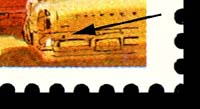 The CBN printing (sc 723A) has two constant plate varieties. When I studied these stamps upon their releases, I spotted a constant variety that occurs on all five stamp sin the second horizontal row of every pane of both plate 2 and plate 3! There is a square colour of brown appearing on the tail light of the car in the foreground. I have dubbed this variety the "dented bumper".
The CBN printing (sc 723A) has two constant plate varieties. When I studied these stamps upon their releases, I spotted a constant variety that occurs on all five stamp sin the second horizontal row of every pane of both plate 2 and plate 3! There is a square colour of brown appearing on the tail light of the car in the foreground. I have dubbed this variety the "dented bumper".
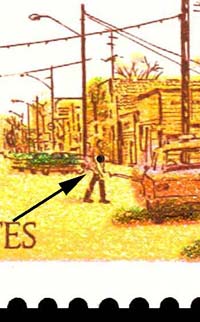 A second constant variety appears on the CBN stamp. The man walking across the street appears with a very large spot of black on his shirt (as if he is wearing a heavy sweater). Based on the relative quantity of used examples found (see below), this variety must occur at only one position on both plates 2 and 3. It is found on stamp 22 (row 5, column 2).
A second constant variety appears on the CBN stamp. The man walking across the street appears with a very large spot of black on his shirt (as if he is wearing a heavy sweater). Based on the relative quantity of used examples found (see below), this variety must occur at only one position on both plates 2 and 3. It is found on stamp 22 (row 5, column 2).
Scarcity/Value
+-------+-------------------+-----------------+-----------+---------+-------+---------+
| | | | Projected | Actual | Inventory |
| Scott | Description | Relative Factor | Used $ | Catalog +-------+---------+
| | | | | Used $ | Count | Factor |
+-------+-------------------+-----------------+-----------+---------+-------+---------+
| 723 | plate 1 | 10 | 1.00 | 0.25 | 35 | 5% |
| BABN +-------------------+-----------------+-----------+---------+-------+---------+
| | red dot above '5' | 1000 (1 in 100) | 100.00 | 7.50 | 1 | -- |
+-------+-------------------+-----------------+-----------+---------+-------+---------+
| | plates 2-3 | 1 | 0.10 | 0.25 | 622 | 95% |
| CBN +-------------------+-----------------+-----------+---------+-------+---------+
| 723A | dented bumper | 10 (1 in 10) | 1.00 | 3.50 | 64 | 1 in 11 |
| +-------------------+-----------------+-----------+---------+-------+---------+
| | black sweater | 50 (1 in 50) | 5.00 | 5.00 | 12 | 1 in 58 |
+-------+-------------------+-----------------+-----------+---------+-------+---------+
Printing totals: BABN (sc 723) - 8.65 million (9.2%); CBN (sc 723A) - 85.25 million (90.8%)
A couple of observations:
Errors/Other
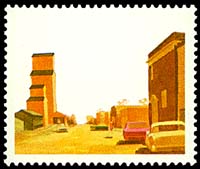 The CBN printing can also be found with the brown inscriptions missing ($2500 mint) or with a complete doubling of the brown inscriptions ($750 mint). Printing shifts of the engraved printing are plentiful; some of the more dramatic shifts can produce captivating results.
The CBN printing can also be found with the brown inscriptions missing ($2500 mint) or with a complete doubling of the brown inscriptions ($750 mint). Printing shifts of the engraved printing are plentiful; some of the more dramatic shifts can produce captivating results.
© 1995-2017, 2018 Robin Harris
Adminware is a trademark of Adminware Corporation.
